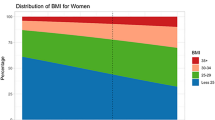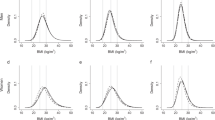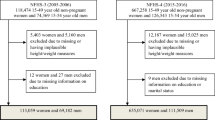Abstract
Background:
The prevalence of excess body weight, commonly measured as body mass index (BMI)⩾25 kg m−2, has increased substantially in many populations worldwide over the past three decades, but the rate of increase has slowed down in some western populations.
Objective:
We address the hypothesis that the slowing down of BMI trend increases in England reflects a majority sub-population resistant to further BMI elevation.
Design:
Pseudo-panel data derived from annual cross-sectional surveys, the Health Surveys for England (1992–2010). Trends in median BMI values were explored using regression models with splines, and gender-specific mixture model (latent class analysis) were fit to take an account of increasing BMI distribution variance with time and identify hidden subgroups within the population.
Subjects:
BMI was available for 164 155 adults (men: 76 382; women: 87 773).
Results:
Until 2001, the age-adjusted yearly increases in median BMI were 0.140 and 0.139 kg m−2 for men and women, respectively, decreasing thereafter to 0.073 and 0.055 kg m−2 (differences between time periods, both P-values<0.0001). The mixture model identified two components—a normal BMI and a high BMI sub-population—the proportions for the latter were 23.5% in men and 33.7% in women. The remaining normal BMI populations were ‘resistant’ with minimal increases in mean BMI values over time. By age, mean BMI values in the normal BMI sub-population increased greatest between 20 and 34 years for men; for women, the increases were similar throughout age groups (slope differences, P<0.0001).
Conclusion:
In England, recent slowing down of adult BMI trend increases can be explained by two sub-populations—a high BMI sub-population getting ‘fatter’ and a majority ‘resistant’ normal BMI sub-population. These findings support a targeted, rather than a population-wide, policy to tackle the determinants of obesity.
This is a preview of subscription content, access via your institution
Access options
Subscribe to this journal
Receive 12 print issues and online access
$259.00 per year
only $21.58 per issue
Buy this article
- Purchase on Springer Link
- Instant access to full article PDF
Prices may be subject to local taxes which are calculated during checkout




Similar content being viewed by others
References
Wormser D, Kaptoge S, Di Angelantonio E, Wood AM, Pennells L, Thompson A et al. Separate and combined associations of body-mass index and abdominal adiposity with cardiovascular disease: collaborative analysis of 58 prospective studies. Lancet 2011; 377: 1085–1095.
Vazquez G, Duval S, Jacobs DR Jr, Silventoinen K . Comparison of body mass index, waist circumference, and waist/hip ratio in predicting incident diabetes: a meta-analysis. Epidemiol Rev 2007; 29: 115–128.
Renehan A, Tyson M, Egger M, Heller RF, Zwahlen M . Body mass index and incidence of cancer: a systematic review and meta-analysis of prospective observational studies. Lancet 2008; 371: 569–578.
World Health Organization. Global Health Risks: Mortality and Burden of Disease Attributable to Selected Major Risks. World Health Organization: Geneva, Switzerland, 2009.
Lim SS, Vos T, Flaxman AD, Danaei G, Shibuya K, Adair-Rohani H et al. A comparative risk assessment of burden of disease and injury attributable to 67 risk factors and risk factor clusters in 21 regions, 1990-2010: a systematic analysis for the Global Burden of Disease Study 2010. Lancet 2012; 380: 2224–2260.
Finucane MM, Stevens GA, Cowan MJ, Danaei G, Lin JK, Paciorek CJ et al. National, regional, and global trends in body-mass index since 1980: systematic analysis of health examination surveys and epidemiological studies with 960 country-years and 9.1 million participants. Lancet 2011; 377: 557–567.
Rokholm B, Baker JL, Sorensen TI . The levelling off of the obesity epidemic since the year 1999—a review of evidence and perspectives. Obes Rev 2010; 11: 835–846.
Howel D . Trends in the prevalence of obesity and overweight in English adults by age and birth cohort, 1991-2006. Public Health Nutr 2011; 14: 27–33.
Flegal KM, Carroll MD, Kit BK, Ogden CL . Prevalence of obesity and trends in the distribution of body mass index among US adults, 1999-2010. JAMA 2012; 307: 491–497.
Flegal KM, Carroll MD, Ogden CL, Curtin LR . Prevalence and trends in obesity among US adults, 1999-2008. JAMA 2010; 303: 235–241.
McPherson K, Marsh T, Brown J, Foresight Working Group Trends and Drivers of Obesity: A Literature Review for the Foresight project on Obesityhttp://www.foresight.gov.uk/Obesity/Outputs/Literature_Review/Literature_review.htmLondon, UK, 2007.
Zaninotto P, Head J, Stamatakis E, Wardle H, Mindell J . Trends in obesity among adults in England from 1993 to 2004 by age and social class and projections of prevalence to 2012. J Epidemiol Community Health 2009; 63: 140–146.
Wang YC, McPherson K, Marsh T, Gortmaker SL, Brown M . Health and economic burden of the projected obesity trends in the USA and the UK. Lancet 2011; 378: 815–825.
Verbeek M . Pseudo-panels and repeated cross-sections. In: Mátyás L, Sevestre P (eds) The Econometrics of Panel Data: Fundamentals and Recent Developments in Theory and Practice. Springer: Berlin Heidelberg, 2008. pp 369–383.
Health Survey for England, The Economic and Social Data Service (ESDS). http://www.esds.ac.uk/government/hse/ (accessed 1 March 2013).
Craig R, Mindell J . Health Survey for England 2006. In Cardiovascular Diseases and Risk Factors in Adults. The Information Centre: London, UK, 2008.
Craig R, Mindell J . Health Survey for England 2006. In Methodology and Documentation. The Information Centre: London, UK, 2008.
McLachlan GJ, Peel D . Finite Mixture Models. Wiley: New York, NY, USA, 2000.
Majer IM, Mackenbach JP, van Baal PH . Time trends and forecasts of body mass index from repeated cross-sectional data: a different approach. Stat Med 2012; 32: 1561–1571.
Kuczmarski MF, Kuczmarski RJ, Najjar M . Effects of age on validity of self-reported height, weight, and body mass index: findings from the Third National Health and Nutrition Examination Survey, 1988-1994. J Am Diet Assoc 2001; 101: 28–34 quiz 35–36.
Ahn J, Schatzkin A, Lacey JV Jr, Albanes D, Ballard-Barbash R, Adams KF et al. Adiposity, adult weight change, and postmenopausal breast cancer risk. Arch Intern Med 2007; 167: 2091–2102.
Harvie M, Howell A, Vierkant RA, Kumar N, Cerhan JR, Kelemen LE et al. Association of gain and loss of weight before and after menopause with risk of postmenopausal breast cancer in the Iowa women's health study. Cancer Epidemiol Biomarkers Prev 2005; 14: 656–661.
Thygesen LC, Gronbaek M, Johansen C, Fuchs CS, Willett WC, Giovannucci E . Prospective weight change and colon cancer risk in male US health professionals. Int J Cancer 2008; 123: 1160–1165.
Schlesselman JJ . Case-Control Studies. Design, Conduct, Analysis. Oxford University Press: New York, NY, USA, 1982.
Stafford M, Brunner EJ, Head J, Ross NA . Deprivation and the development of obesity a multilevel, longitudinal study in England. Am J Prev Med 2010; 39: 130–139.
Stamatakis E, Chaudhury M . Temporal trends in adults' sports participation patterns in England between 1997 and 2006: the Health Survey for England. Br J Sports Med 2008; 42: 901–908.
Butland B, Jebb SA, Kopelman P . Foresight Tackling Obesities: Future Choices—Project Report. Department of Innovation, Universities and Skills: London, UK, 2007.
Norberg M, Lindvall K, Stenlund H, Lindahl B . The obesity epidemic slows among the middle-aged population in Sweden while the socioeconomic gap widens. Glob Health Action e-pub ahead of print 10 December 2010 doi:10.3402/gha.v3i0.5149.
Faeh D, Bopp M . Excess weight in the canton of Zurich, 1992-2009: harbinger of a trend reversal in Switzerland? Swiss Med Wkly 2010; 140: w13090.
Garcia-Alvarez A, Serra-Majem L, Ribas-Barba L, Castell C, Foz M, Uauy R et al. Obesity and overweight trends in Catalonia, Spain (1992-2003): gender and socio-economic determinants. Public Health Nutr 2007; 10: 1368–1378.
Renehan AG, Soerjomataram I, Leitzmann MF . Interpreting the epidemiological evidence linking obesity and cancer: a framework for population-attributable risk estimations in Europe. Eur J Cancer 2010; 46: 2581–2592.
Renehan AG, Flood A, Adams KF, Olden M, Hollenbeck AR, Cross AJ et al. Body mass index at different adult ages, weight change, and colorectal cancer risk in the National Institutes of Health-AARP Cohort. Am J Epidemiol 2012; 176: 1130–1140.
Bray GA, Champagne CM . Beyond energy balance: there is more to obesity than kilocalories. J Am Diet Assoc 2005; 105 (5 Suppl 1): S17–S23.
Acknowledgements
This study was partly funded by the ESRC Obesity eLab Grant (RES-149-25-1076).
DISCLAIMER
AGR holds a senior lectureship award supported by the UK Clinical Research Collaboration. The corresponding author had full access to all data in the study and had final responsibility for the decision to submit for publication.
Author information
Authors and Affiliations
Corresponding author
Ethics declarations
Competing interests
The authors declare no conflict of interest.
Additional information
AUTHOR CONTRIBUTIONS
IEB originated the hypothesis. MS, AGR and IEB developed the study analysis protocol. ADM and VH extracted the data. MS and AGR undertook the statistical analyses. All authors contributed to the interpretation of the results and writing of the manuscript.
Supplementary Information accompanies this paper on International Journal of Obesity website
Supplementary information
Rights and permissions
About this article
Cite this article
Sperrin, M., Marshall, A., Higgins, V. et al. Slowing down of adult body mass index trend increases in England: a latent class analysis of cross-sectional surveys (1992–2010). Int J Obes 38, 818–824 (2014). https://doi.org/10.1038/ijo.2013.161
Received:
Revised:
Accepted:
Published:
Issue Date:
DOI: https://doi.org/10.1038/ijo.2013.161
Keywords
This article is cited by
-
The associations of maternal and paternal obesity with latent patterns of offspring BMI development between 7 and 17 years of age: pooled analyses of cohorts born in 1958 and 2001 in the United Kingdom
International Journal of Obesity (2023)
-
Changes over time in latent patterns of childhood-to-adulthood BMI development in Great Britain: evidence from three cohorts born in 1946, 1958, and 1970
BMC Medicine (2021)
-
Long-term body mass trajectories and hypertension by sex among Chinese adults: a 24-year open cohort study
Scientific Reports (2021)
-
Young adulthood body mass index, adult weight gain and breast cancer risk: the PROCAS Study (United Kingdom)
British Journal of Cancer (2020)
-
Differences in magnitude and rates of change in BMI distributions by socioeconomic and geographic factors in Mexico, Colombia, and Peru, 2005–2010
European Journal of Clinical Nutrition (2020)



